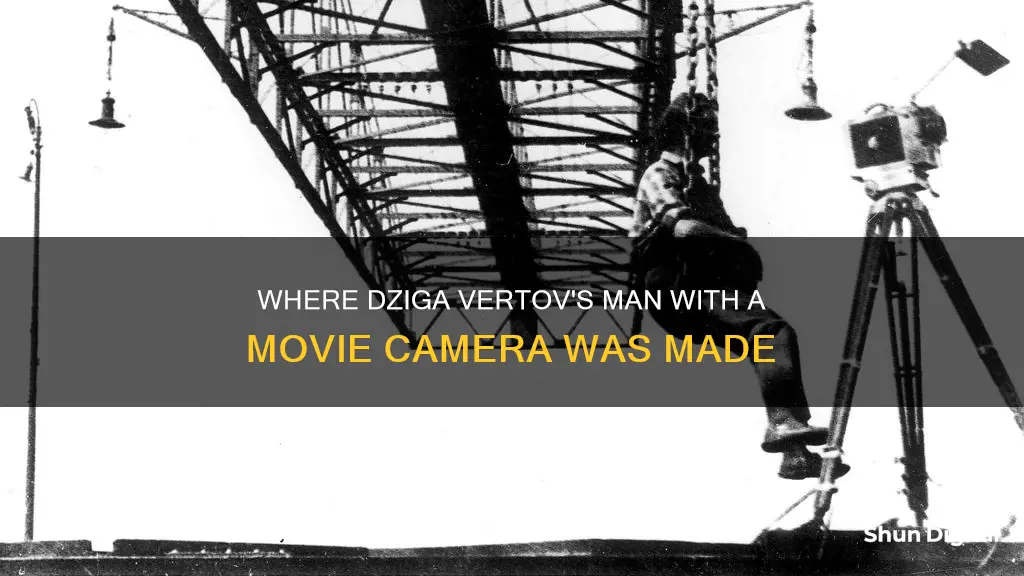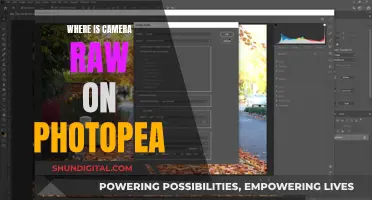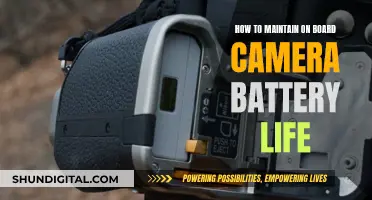
Man with a Movie Camera, a 1929 Soviet silent documentary film, was produced by the film studio All-Ukrainian Photo Cinema Administration (VUFKU). The film, directed by Dziga Vertov, is a narrative-free portrait of city life, showcasing urban life in Moscow, Kiev, and Odessa during the late 1920s. With its experimental style and innovative cinematic techniques, it has earned its place as one of the greatest films in cinema history, despite initial criticism for its departure from conventional storytelling.
| Characteristics | Values |
|---|---|
| Year | 1929 |
| Original Title | Chelovek s kino-apparatom |
| Director | Dziga Vertov |
| Film Studio | All-Ukrainian Photo Cinema Administration (VUFKU) |
| Cinematography | Mikhail Kaufman |
| Editor | Yelizaveta Svilova |
| Runtime | 68 minutes |
| Average Shot Length | 2.3 seconds |
What You'll Learn

Man with a Movie Camera was produced by the film studio All-Ukrainian Photo Cinema Administration (VUFKU)
Vertov's feature film is known for its experimental style and the wide range of innovative cinematic techniques it employs, including multiple exposures, fast and slow motion, freeze frames, match cuts, jump cuts, split screens, Dutch angles, extreme close-ups, tracking shots, reversed footage, and stop-motion animation. The film's editing, supervised by Vertov's wife Yelizaveta Svilova, is particularly notable for its fast cutting and use of montage.
The film was largely dismissed upon its initial release due to its emphasis on form over content and its break from traditional theatrical conventions. However, it has since been recognized for its significance and influence on cinema, with film critics voting it the best documentary of all time.
The film was produced shortly after Stalin took power in 1928, and the government disapproved of Vertov's film style, considering it formalist. Vertov moved to Kiev to produce the film, where the government's restrictions were less stringent.
Man with a Movie Camera stands as a landmark in film history, showcasing Vertov's radical artistic vision and mastery of the cinematic medium. It continues to inspire and influence filmmakers, even nearly a century after its release.
Charging the Kitmesh Camera: A Quick Guide
You may want to see also

It was filmed in Moscow, Kiev, Kharkov and Odessa
"Man with a Movie Camera" is a 1929 Soviet experimental documentary film directed by Dziga Vertov, with cinematography by his brother, Mikhail Kaufman, and editing by Vertov's wife, Yelizaveta Svilova. The film was produced by the studio All-Ukrainian Photo Cinema Administration (VUFKU).
The film was shot over a period of about three years in four cities: Moscow, Kiev, Kharkov, and Odessa. It captures urban life in these cities during the late 1920s, showcasing Soviet citizens at work and leisure, and their interactions with modern machinery.
Moscow, the capital of Russia, offered iconic locations such as the Bolshoi Theatre, Strastnaya Square, and Kuznetsky Most. Kiev, the capital of Ukraine, featured Khreschatyk Street, Sofiys'ka Square, and the Park Bridge. Kharkov, also in Ukraine, was another shooting location, though specific sites within the city are not mentioned. Odessa, a port city in Ukraine, provided backdrops like Prymorskyi Boulevard, the Port, Arcadia Beach, and Kuyal'nik Resort.
The film's crew, including Vertov, Svilova, and Kaufman, travelled to these diverse locations to capture the range of urban environments and social classes that defined Soviet life in the late 1920s.
Olympus Cameras: Made in Japan?
You may want to see also

The film was directed by Dziga Vertov
The 1929 film Man with a Movie Camera was directed by Dziga Vertov, a Soviet pioneer documentary filmmaker, writer, editor, and newsreel director. Vertov, born David Abelevich Kaufman, was also a cinema theorist who influenced the cinéma vérité style of documentary filmmaking.
Vertov's Man with a Movie Camera is a silent documentary film that presents urban life in Moscow, Kiev, and Odessa during the late 1920s. The film has no actors, but instead, follows Soviet citizens at work and play, interacting with modern machinery. The film's only protagonist is the cameraman himself, played by Vertov's brother, Mikhail Kaufman.
Vertov's film is known for its experimental style and the wide range of cinematic techniques it employs, including multiple exposures, fast and slow motion, freeze frames, match cuts, jump cuts, split screens, Dutch angles, extreme close-ups, tracking shots, reversed footage, and stop-motion animation. The film also features some staged situations, such as the cameraman's actions and a woman getting dressed.
Dziga Vertov was part of a movement of filmmakers known as the Kinoks or Kino-eyes, who aimed to abolish non-documentary styles of filmmaking. Vertov's work was often controversial and criticised for its focus on form over content. Despite this, Man with a Movie Camera is now regarded as one of the greatest films ever made, with critics praising its exploration of the medium and its sociological value.
In addition to his work on Man with a Movie Camera, Vertov also directed other notable films, including Three Songs About Lenin (1934) and The Sixth Part of the World (1926). He was married to fellow filmmaker and editor Yelizaveta Svilova, who collaborated with him on many projects.
Low Power Mode: Impact on Camera Performance
You may want to see also

It was filmed by Vertov's brother, Mikhail Kaufman
Man with a Movie Camera is an experimental 1929 Soviet silent documentary film directed by Dziga Vertov. It was filmed by his brother, Mikhail Kaufman, a cinematographer and photographer. Kaufman was born in 1897 in the Russian Empire and had a passion for technical devices and photography from a young age. He served in the Red Army during the Russian Civil War and returned to work with his brother on his newsreel series, Kino-Pravda, as a cameraman.
Kaufman's work on Man with a Movie Camera is remarkable for its innovative visual effects and daring camerawork. He appears in the film as the eponymous "Man," documenting urban life with his camera. Kaufman's character is shown climbing smokestacks, hanging off trains, and crawling underground with miners to capture the perfect shot. His camerawork pushed the boundaries of what was possible in filmmaking at the time and helped to develop new techniques such as "sudden life capture."
In addition to his work on Man with a Movie Camera, Kaufman directed three films: Moscow (1927), In Spring (1929), and An Unprecedented Campaign (1931). He was also a co-author and cameraman on several other films, including Cine-Eye (1924) and The Sixth Part of the World (1926). Unfortunately, Kaufman and Vertov had a falling out over artistic differences after the filming of Man with a Movie Camera and never worked together again.
The film Man with a Movie Camera was produced by the All-Ukrainian Photo Cinema Administration (VUFKU) and showcases urban life in Moscow, Kiev, and Odessa during the late 1920s. It is known for its wide range of cinematic techniques, including multiple exposures, fast and slow motion, freeze frames, and jump cuts. The film has received widespread acclaim and is considered one of the greatest films ever made.
Dewalt Inspection Camera: Charging the Screen Efficiently
You may want to see also

Vertov's wife, Yelizaveta Svilova, edited the film
The 1929 film Man with a Movie Camera was produced by the film studio All-Ukrainian Photo Cinema Administration (VUFKU). It was directed by Dziga Vertov, filmed by his brother Mikhail Kaufman, and edited by Vertov's wife, Yelizaveta Svilova.
Yelizaveta Ignatevna Svilova (born Elizaveta Schnitt) was a Russian filmmaker and film editor. She was born in Moscow on 5 September 1900 and began working in the cinema industry at the age of twelve. At fourteen, she was hired as an assistant editor at Pathé's Moscow studio, where she worked until 1918. She then joined the film department of Narkompros, the People's Commissariat of Education, where she worked as an editor for four years. In 1922, she joined Goskino, the centralized state-run production and distribution company.
Svilova met Vertov in 1919 while working as a film editor. They married in 1923 and collaborated on many films throughout their marriage. Svilova was a key member of Vertov's Kino-Eye group, taking a leading role in the Kinoki collective, which also included Vertov and his brother, Mikhail Kaufman. The group advocated for a documentary film style that captured the reality of everyday life in the Soviet Union. Svilova's role as the group's editor was crucial, as she worked on-site at film shoots and used her editorial eye to choose locations and subjects to be filmed.
In addition to Man with a Movie Camera, Svilova collaborated with Vertov on films such as Kino Pravda (1922-1925), Kino Eye (1924), Stride Soviet! (1926), A Sixth of the World (1926), Enthusiasm (1931), and Three Songs of Lenin (1934). She also directed and edited several films independently, including Bukhara (1927) and For You at the Front (1942). Svilova continued to work in film after Vertov's death in 1954, and she was the director-editor of over 100 documentaries and newsreel episodes from 1939 to 1956. She also taught montage at the Lenin Institute and promoted the Kinoki's early work. Svilova passed away in 1975 in Moscow and is buried in Novodevichy Cemetery.
Solar Power for Your Swann Cameras: A Guide
You may want to see also
Frequently asked questions
The film was produced by the All-Ukrainian Photo Cinema Administration (VUFKU).
The film is a documentary about urban life in Moscow, Kiev, and Odessa during the late 1920s.
The film was directed by Dziga Vertov.
Vertov's brother, Mikhail Kaufman, was the cinematographer.
The film is known for its use of multiple exposures, fast and slow motion, freeze frames, jump cuts, split screens, Dutch angles, extreme close-ups, and tracking shots, among others.







